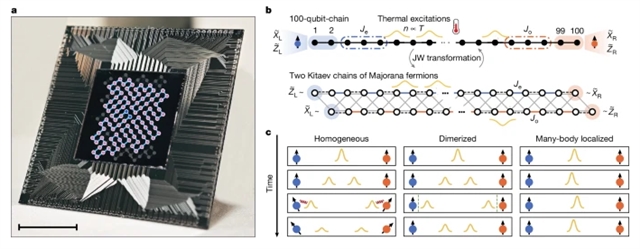
近日,浙江大学邓东灵团队研究了超导处理器的拓扑预热强零模式。该研究于2025年8月27日发表在《自然》杂志上。
对称保护拓扑相不能用任何局部序参数来描述,并且超出了传统的对称破缺模型。它们的特征是拓扑边界模在对称扰动下保持稳定。在没有无序的干净、有间隙的系统中,这些边缘模式的稳定性仅限于零温流形;在有限温度下,与移动热激发的相互作用会导致它们的衰变。
研究组报道了在100个可编程超导量子比特阵列中观察到的一种不同类型的拓扑边缘模式,这种模式受到紧急对称性的保护,并在整个光谱中持续存在。通过对一维无无序稳定器哈密顿量的数字量子模拟,研究组观察到在高达30个周期内,对于广泛的初始态,存在鲁棒的长寿命拓扑边模。研究表明,通过使稳定器强度二聚化,可以抑制这些边缘模式和体激发之间的相互作用,从而产生U(1)× U(1)系统预热状态下的对称性。
研究组利用这些拓扑边模作为逻辑量子位,并制备了一个逻辑贝尔态,尽管系统在有限温度下没有无序,但它表现出持久的相干性。该研究结果建立了一种可行的数字模拟方法,用于在有限温度下实验研究拓扑物质,并展示了在没有无序的系统中构建长寿命、鲁棒的边界量子位的潜在途径。
附:英文原文
Title: Topological prethermal strong zero modes on superconducting processors
Author: Jin, Feitong, Jiang, Si, Zhu, Xuhao, Bao, Zehang, Shen, Fanhao, Wang, Ke, Zhu, Zitian, Xu, Shibo, Song, Zixuan, Chen, Jiachen, Tan, Ziqi, Wu, Yaozu, Zhang, Chuanyu, Gao, Yu, Wang, Ning, Zou, Yiren, Zhang, Aosai, Li, Tingting, Zhong, Jiarun, Cui, Zhengyi, Han, Yihang, He, Yiyang, Wang, Han, Yang, Jia-Nan, Wang, Yanzhe, Shen, Jiayuan, Liu, Gongyu, Deng, Jinfeng, Dong, Hang, Zhang, Pengfei, Li, Weikang, Yuan, Dong, Lu, Zhide, Sun, Zheng-Zhi, Li, Hekang, Zhang, Junxiang, Song, Chao, Wang, Zhen, Guo, Qiujiang, Machado, Francisco, Kemp, Jack, Iadecola, Thomas, Yao, Norman Y., Wang, H., Deng, Dong-Ling
Issue&Volume: 2025-08-27
Abstract: Symmetry-protected topological phases1,2,3,4 cannot be described by any local order parameter and are beyond the conventional symmetry-breaking model5. They are characterized by topological boundary modes that remain stable under symmetry respecting perturbations1,2,3,4,6,7,8. In clean, gapped systems without disorder, the stability of these edge modes is restricted to the zero-temperature manifold; at finite temperatures, interactions with mobile thermal excitations lead to their decay9,10,11. Here we report the observation of a distinct type of topological edge mode12,13,14, which is protected by emergent symmetries and persists across the entire spectrum, in an array of 100 programmable superconducting qubits. Through digital quantum simulation of a one-dimensional disorder-free stabilizer Hamiltonian, we observe robust long-lived topological edge modes over up to 30 cycles for a wide range of initial states. We show that the interaction between these edge modes and bulk excitations can be suppressed by dimerizing the stabilizer strength, leading to an emergent U(1)×U(1) symmetry in the prethermal regime of the system. Furthermore, we exploit these topological edge modes as logical qubits and prepare a logical Bell state, which exhibits persistent coherence, despite the system being disorder-free and at finite temperature. Our results establish a viable digital simulation approach15,16,17,18 to experimentally study topological matter at finite temperature and demonstrate a potential route to construct long-lived, robust boundary qubits in disorder-free systems.
DOI: 10.1038/s41586-025-09476-z
Source: https://www.nature.com/articles/s41586-025-09476-z
Nature:《自然》,创刊于1869年。隶属于施普林格·自然出版集团,最新IF:69.504
官方网址:http://www.nature.com/
投稿链接:http://www.nature.com/authors/submit_manuscript.html
